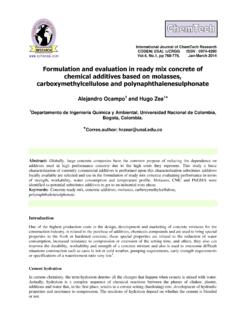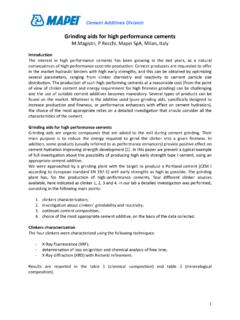Transcription of Solidification/Stabilization of Organic and Inorganic ...
1 1 Solidification/Stabilization of Organic and Inorganic Contaminants using Portland cement : A literature review Santanu Pariaa and Pak K. Yuet Department of Process Engineering and Applied Science, Dalhousie University Box 1000, Halifax, NS, Canada B3J 2X4 a Current address: Mineral Processing Division, National Metallurgical Laboratory (CSIR), Jamshedpur-831007, India. Corresponding author: Pak K. Yuet Department of Process Engineering and Applied Science, Dalhousie University, Box 1000, Halifax, NS, Canada B3J 2X4 Tel: 902-494-3213 Fax: 902-420-7639 E-mail: Santanu Paria and Pak K.
2 Yuet 2 Abstract The treatment of hazardous wastes using cement -based Solidification/Stabilization (S/S) is of increasing importance as an option for remediating contaminated sites. Indeed, among the various treatment techniques, S/S is one of the most widely used methods for treating Inorganic wastes. To enhance the application of S/S and to further develop this technology for site remediation, particularly for Organic contaminants, it is important to have a better understanding of the mechanisms involved in the process. The primary objective of this review is to survey our current knowledge in this subject, focusing on (i) cement chemistry , (ii) the effects of Inorganic (heavy metals) and Organic compounds on cement hydration, and (iii) the mechanisms of immobilization of different Organic and Inorganic compounds.
3 For heavy metals, cement -based S/S technology has been shown to be effective in immobilizing the contaminants, even without any additives . In applying cement -based S/S for treating Organic contaminants, the use of adsorbents such as organophilic clay and activated carbon, either as a pretreatment or as additives in the cement mix, can improve contaminant immobilization in the solidified/stabilized wastes. The concept of degradative Solidification/Stabilization , which combines chemical degradation with conventional Solidification/Stabilization , seems promising, although further study is required to assess its technical and economic feasibility.
4 Key words: Portland cement , stabilization, solidification, Organic contaminants 3 1 Introduction cement -based Solidification/Stabilization (S/S) is a chemical treatment process which aims to either bind or complex the compounds of a hazardous waste stream into a stable insoluble form (stabilization) or to entrap the waste within a solid cementitious matrix (solidification) (Wiles 1987). The Environmental Protection Agency (EPA) has identified S/S as the best demonstrated available technology for 57 RCRA (Resource Conservation and Recovery Act)-listed hazardous wastes, and S/S technology was selected in 24% of all source control treatments at Superfund remedial action sites in the United States (see Figure 1) ( EPA 2004).
5 Compared with other remediation technologies, cement -based S/S has the following advantages (Conner and Hoeffner 1998; Shi and Spence 2004): Relatively low cost and ease of use and processing, Composition of Portland cement is consistent from source to source, eliminating some of the variables in designing the S/S process, Good long-term stability, both physical and chemical, Good impact and comprehensive strength, Non-toxicity of the chemical ingredients, High resistance to biodegradation, and Relatively low water permeability.
6 Stabilization of heavy metals is mainly achieved by converting the heavy metals into insoluble precipitates. Organic compounds are generally nonpolar and hydrophobic; they do not react with the Inorganic binders and may interfere with the hydration reactions of cement or pozzolanic materials and inhibit the setting of cement . Instead, organics are generally sorbed or encapsulated in the pores, and their leachability depends on their solubility in water and their 4 diffusivity through the waste matrix. In S/S processes, immobilization of contaminants, depending on their nature, occurs by three main mechanisms: 1.
7 Chemical fixation of contaminants by interactions between the hydration products of cement and the contaminants, 2. Physical adsorption of contaminants on the surface of cement hydration products, or 3. Physical encapsulation of contaminated waste or soil. Solidification/Stabilization processes can be applied using several schemes (Wiles 1987): In-drum processing In this process, the S/S binders are added to the waste contained in a drum or other container. The waste-binder matrix is normally disposed of in the drum after mixing and setting.
8 In-plant processing A plant and/or process is specifically designed for solidifying and stabilizing bulk waste materials. The process may be used to manage wastes from an internal industrial operation, or a plant may be specifically built and operated to solidify and stabilize wastes from external sources. Mobile plant (ex situ) processing In this scheme, the processing equipment, which is either mobile or can be easily transported, is set up site to site. In-situ processing Binders or solidifying/stabilizing materials are injected directly to a lagoon or soil subsurface to promote the Solidification/Stabilization of the contaminated sludge or soil.
9 2 Soil To facilitate the design of S/S processes, it is important to have a thorough knowledge of the physical and chemical properties of soil, and to understand the mechanisms of interactions between soil and contaminants. 5 Chemical and physical properties Soil can be defined as loose materials composed of weathered rock and other minerals, as well as partly decayed Organic matter (Wild 1993). The soil components include about 50% by volume mineral particles, 25% water, 20% air, and 5% Organic matter. Except for a few Organic soils, the bulk of soil is derived from solid geological deposits and is mineral in character.
10 Table 1 lists the general chemical formulae of the major minerals in soil. The mineral particles in soil vary widely in size, shape, and chemical composition. Three groupings of soil particles are in common use, namely sand, silt, and clay, which can be further subdivided according to specific requirements. The different particle size limits are given in Table 2. Because of their structure and chemical composition, humus and clay minerals, which are mainly aluminosilicates and hydrous or hydrated oxides of iron and aluminum, usually bear negative charges.











